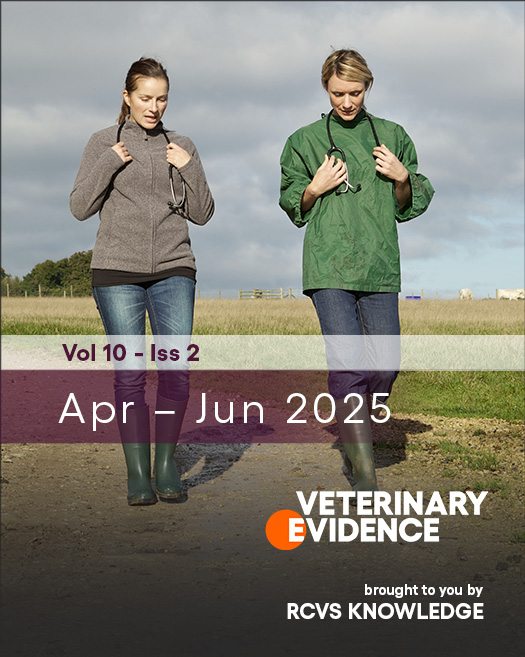DOI
https://doi.org/10.18849/ve.v10i2.696Abstract
Question
In cats diagnosed with isolated rupture of the cranial cruciate ligament, does surgical intervention result in improved long-term function, when compared with conservative management?
Clinical bottom line
The category of research question was:
Treatment.
The number and type of study designs that were critically appraised were:
One retrospective cohort study comparing surgical management and conservative management.
Critical appraisal of the selected papers meeting the inclusion criteria collectively provide zero/weak/moderate/strong evidence in terms of their experimental design and implementation:
Weak.
The outcomes reported are summarised as follows…
This study evaluated and compared the long-term Feline Musculoskeletal Pain Index (FMPI) of patients with a cranial cruciate injury (39–87 months post injury). Patients that were managed conservatively showed statistically significant (P = 0.017) lower FMPI scores long term.
In view of the strength of evidence and the outcomes from the studies the following conclusion is made…
Conservative management can be considered in cats presenting with isolated cranial cruciate rupture; however, further research is required to establish the optimum treatment in these cases. Given the limitations of this study and the current lack of evidence, clinicians must rely on their clinical judgement at this point when managing this condition until further research is available.
References
Amimoto, H., Koreeda, T., Ochi Y., Kimura, R., Akiyoshi, H., Nishida, H., Miyabayashi, T., Beale, B.S., Hayashi, K. & Wada, N. (2020). Force Plate Gait Analysis and Clinical Results after Tibial Plateau Levelling Osteotomy for Cranial Cruciate Ligament Rupture in Small Breed Dogs. Veterinary Comparative Orthopaedics and Traumatology. 33(3), 183-188. DOI: https://doi.org/10.1055/s-0039-1700990
Bergh, M.S., Sullivan C., Ferrell, C.L., Troy, J. & Budsbery, S.C. (2014). Systematic Review of Surgical Treatments for Cranial Cruciate Ligament Disease in Dogs. Journal of the American Animal Hospital Association. 50(5), 315– DOI: https://doi.org/10.5326/JAAHA-MS-6356
Boge, G.S., Engdahl, K., Moldal, E.R. & Bergström, A. (2020). Cranial cruciate ligament disease in cats: an epidemiological retrospective study in 50 cats (2011–2016). Journal of Feline Medicine and Surgery. 22(4), 277– DOI: https://doi.org/10.1177/1098612X19837436
Brioschi, V. & Arthurs, G.I. (2021). Cranial cruciate ligament rupture in small dogs (<15kg): a narrative literature review. Journal of Small Animal Practice. 62(12), 1037– DOI: https://doi.org/10.1111/jsap.13404
Comerford, E., Forster, K., Gorton, K. & Maddox, T. (2013). Management of cranial cruciate ligament rupture in small dogs: a questionnaire study. Veterinary Comparative Orthopaedics and Traumatology. 26(6), 493– DOI: https://doi.org/10.3415/VCOT-12-06-0070
Coppola, M., Das, S., Matthews, M., Cantatore, M., Silva, L., Lafuente, P., Kulendra, E., Clarke, H., McCarthy, J, Fernadez-Salesa, N., Langley-Hobbs, S., Aisa, J., Parkin, T. & Addison, E.S. (2022). Traumatic stifle injury in 72 cats: a multicentre retrospective study. Journal of Feline Medicine and Surgery. 24(6), 587– DOI: https://doi.org/10.1177/1098612X211028834
Gordon-Evans, W.J., Griffon, D.J., Bubb, C., Knap, K.M., Sullivan, M. & Evans, R.B. (2013). Comparison of lateral fabellar suture and tibial plateau leveling osteotomy techniques for treatment of dogs with cranial cruciate ligament disease. Journal of the American Veterinary Medical Association. 243(5), 675– DOI: https://doi.org/10.2460/javma.243.5.675
Griffon, D.J. (2010). A Review of the Pathogenesis of Canine Cranial Cruciate Ligament Disease as a Basis for Future Preventive Strategies. Veterinary Surgery. 39(4), 399– DOI: https://doi.org/10.1111/j.1532-950X.2010.00654.x
Harasen, G.L.G. (2005). Feline cranial cruciate rupture: 17 cases and a review of the literature. Veterinary and Comparative Orthopaedics and Traumatology. 18(4), 254– DOI: https://doi.org/10.1055/s-0038-1632963
Kwananocha, I., Akaraphutiporn, E., Upaiiputti, R., Lekchareonsuk, C. & Wangdee, C. (2024). Short-term outcomes of cranial cruciate ligament rupture treated surgically with tibial plateau leveling osteotomy or non-surgically in small-breed dogs weighing less than 10kg. The Journal of Veterinary Medical Science. 86(4), 428– DOI: https://doi.org/10.1292/jvms.23-0512
Minder, J.K., Bielecki, M.J., Scharvogel, S.S. & Meiler, D. (2016). Tibial plateau levelling osteotomy in eleven cats with cranial cruciate ligament rupture. Veterinary and Comparative Orthopaedics and Traumatology. 29(6), 528–535 DOI: https://doi.org./10.3415/VCOT-15-11-0184
Pond, M.J. & Campbell, J.R. (1972). The canine stifle joint I. Rupture of the anterior cruciate ligament. An assessment of conservative and surgical treatment. Journal of Small Animal Practice. 13(1), 1–10 DOI: https://doi.org/10.1111/j.1748-5827.1972.tb06791.x
Sen, I. (2019). Clinical and Radiological Evaluation of the Treatment of Cranial Cruciate Ligament Rupture in Cats with the Musculus Biceps Femoris Transposition Technique. Acta Veterinaria-Beograd. 69(3), 300– DOI: https://doi.org/10.2478/acve-2019-0025
Stadig, S., Lascelles, B.D.X. & Bergh, A. (2016). Do cats with a cranial cruciate ligament injury and osteoarthritis demonstrate a different gait pattern and behaviour compared to sound cats. Acta Veterinaria Scandinavica. 58(1). DOI: https://doi.org/10.1186/s13028-016-0248-x
Stadig, S., Lascelles, B.D.X., Nyman, G. & Bergh, A. (2019). Evaluation and comparison of pain questionnaires for clinical screening of osteoarthritis in cats. Veterinary Record. 185(24), 757. DOI: https://doi.org/10.1136/vr.105115
Stoneburner, R.M., Howard, J., Gurian, E.M., Jones, S.C., Karlin, W.M. & Kieves, N.R. (2022). Conservative nonsurgical treatment for cranial cruciate ligament disease can be an effective management strategy in cats based on validated owner-based subjective assessment in some cases. Journal of the American Veterinary Medical Association. 260(12), 1471– DOI: https://doi.org/10.2460/javma.22.01.0009
Taylor-Brown, F.E., Meeson, R.L., Brodbelt, D.C., Church, D.B., McGreevy, P.D., Thomson, P.C. & O’Neill, D.G. (2015). Epidemiology of Cranial Cruciate Ligament Disease Diagnosis in Dogs Attending Primary-Care Veterinary Practices in England. Veterinary Surgery. 44(6), 777–783 DOI: https://doi.org/10.1111/vsu.12349
Vasseur, P.B. (1984). Clinical Results Following Nonoperative Management for Rupture of the Cranial Cruciate Ligament in Dogs. Veterinary Surgery. 13(4), 243–246. DOI: https://doi.org/10.1111/j.1532-950X.1984.tb00801.x
Wessely, M., Reese, S. & Schnabl-Feichter, E. (2017). Aetiology and pathogenesis of cranial cruciate ligament rupture in cats by histological examination. Journal of Feline Medicine and Surgery.19(6), 631– DOI: https://doi.org/10.1177/1098612X16645142
Wucherer, K.L. Conzemius, M.G., Evans, R. & Wilke, V.L. (2013). Short-term and long-term outcomes for overweight dogs with cranial cruciate ligament rupture treated surgically or nonsurgically. Journal of the American Veterinary Medical Association. 242(10), 1364–1372. DOI: https://doi.org/10.2460/javma.242.10.1364
License
Copyright (c) 2025 Philip Montgomery

This work is licensed under a Creative Commons Attribution 4.0 International License.
Veterinary Evidence uses the Creative Commons copyright Creative Commons Attribution 4.0 International License. That means users are free to copy and redistribute the material in any medium or format. Remix, transform, and build upon the material for any purpose, even commercially - with the appropriate citation.
